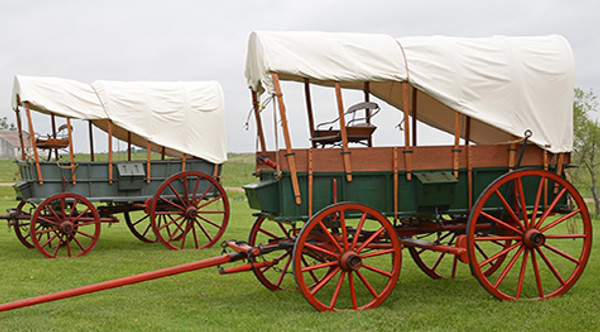Prairie Schooners 1840s and 1850s
Posted by SHOP PROJECT on Sep 28th 2020
Even in the mid-nineteenth century, change could happen in a short period of time. Pictured here are two replica wagons that we just completed at the shop. The one on the left represents the wagons constructed during the period of the 1840s. The one on the right shows the design changes that where implemented in the 1850s. These wagons are complete, newly fabricated historic replicas, of the highest authenticity, following the design features gleaned from original wagons we have documented and/or hold in our collection.

Top Photo: This early California and Oregon Trail Prairie Schooner was replicated after those built in the 1840s. Rave framed box built with angled ends and chipped corners, along with a Colonial Blue finish, shows the influence of the Conestoga wagon design. Running gear has Lynch Pin Clouted (Iron Clad) Axle with rough lock. Stiff pole design for hitch equipment.
Bottom Photo: This later period, 1850s covered wagon has square box with less intricate rave framing and removable top side boards for versatility. The running gear was built using steel skeins for the Lynch Pin axles. We built this particular wagon with a drop pole and included a rough lock.

Top Photo: 1840s Jockey Box style was heavily ironed with intricate hand-forged hardware that secured the box. Chipped corners on the lid matched the style of the wagon box.
Bottom Photo: During the 1850s, craftsmen started to simplify the construction of the Jockey Box. Less hand-forged hardware, but still embellishments added for "style", such as the diamond washer on the bolts that held the box to the wagon. Chipped corners were no longer added, but a curve on the back edge of the lid added styling to the box.

Top Photo: This photo shows the 1840s wagon with stiff pole hounds and early period doubletree "pinned" to the pole with a "Wagon Hammer", which was used to remove the Lynch Pin that went through the wagon axle to secure the wheels.
Bottom Photo: The 1850s wagons increasingly converted to a drop pole, which was found to be recommended by prairie travelers. Intricately crafted hammer strap and wagon hammer shown with the drop pole.

Top Photo: The 1840s banded sill design on the wagon box, prevented the wood of the sill from splitting.
Bottom Photo: The 1850s wagon box sill design omits the bands and adds curved tapered ends. Decorative wagon nails provide additional traction on the "sill tail" for using it as a "step" to get into the wagon.

Top Photo: A traditional design feature of the Conestoga wagon, the sloped side tool box was strapped to the side of the wagon box with an iron band. That same styling along with the chipped edges was implemented in the tool box of the 1840s period wagon.
Bottom Photo: This simpler 1850s tool box design incorporated some added design aspects such as curved wood components. The tool box was secured to the wagon using long bolts through each side rather than being strapped to the wagon box.

Top Photo: 1840s rear tailgate on angled box has pinned through tenon latches and stapled pockets on standard tails.
Bottom Photo: The 1850s period wagon still used a similar, but simplified latch system. Iron loop retainers were added to the tenons with stapled standard tails.

Top Photo: The 1840s box had decorative "chipped" corners. This styling was not only for aesthetics, but also offered some protection from the ends of the boards splitting. The brake lever was an uncommon feature on wagons of this era.
Bottom Photo: The 1850s square box wagon is starting to evolve into the standard "farm box" wagon as the design is simplified and manufacturers start to transition to green as a standard box color. The brake also is becoming a more common feature on western wagons.

Top Photo: Early 1840s hub style has a distinct profile with broad hub bands and a deep lynch pin notch. This is a clouted wood axle with two rivet heads that secure a "cap" to the end of the cloute.
Bottom Photo: The end of the clouted axle era is signified by this cast skein/lynch pin axle. This brief period of axle design was followed by the fabricating of threaded nuts on the ends of the axles to retain the wheel.
We've highlighted only some of the design features of these two wagons. Each craftman (from the wheelwright to the blacksmith, the wainwright to the painter) got emmersed in this replica wagon project. It was a facinating experience producing and learning about history through the production of these wagons.
